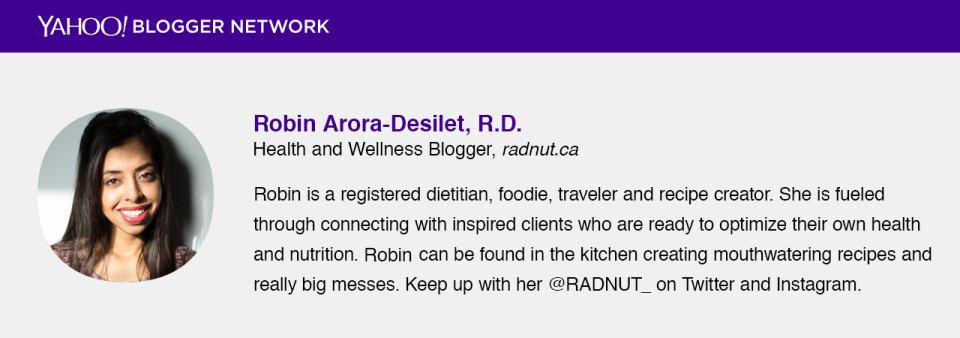8 ways to battle that bloat


Now that we’ve stuffed ourselves full of turkey, potatoes, Brussel sprouts, pumpkin muffins, pumpkin pie, pumpkin everything, it may be time to reconnect with our bellies.
Holiday bloating and abdominal discomfort often result from eating irregular foods, at different times, and in larger quantities. Feeling bloated sometimes is completely normal, but if you struggle with this frequently or every time you’re at a social event, it’s time to reflect on how it happens, what your environmental and food triggers are, and how to prevent it.
Here are eight of my bloat-busting tips! Try only one tip at a time, consistently (e.g. for two weeks), to get a clear picture of what works for your body. If you’re still struggling, connect with your physician and registered dietitian for more support.
1. Get back on schedule
It’s obvious I know, so why don’t we do it? Because we are human and it is completely normal to prefer to “take the path of least resistance.” I get that it’s easier to just eat leftover pie for lunch, but your stomach and digestive tract will thank you if you take 5-8 minutes to make a home-made wrap, sandwich, or salad and get back into your regular eating routine. Remember how you were eating when you didn’t feel so crappy? Let’s do that again!
2. Pay attention and notice if common “tummy trouble” foods are bothering you
Alcohol and caffeine can irritate the gut and increase the frequency of bowel movements (fun, I know). Deep-fried or rich foods can delay stomach emptying and give the sensation of heaviness in our stomach.
Also, foods such as cabbage, cauliflower, broccoli, Brussel sprouts, legumes, carbonated beverages and fruit drinks sweetened with high fructose corn syrup can worsen abdominal discomfort and bloating.
If you know one of these foods is a trigger for you, make a choice to either have a very small quantity or eliminate that one food for 3-4 weeks. After elimination, re-introduce the food in gradually increasing quantities (start small like ¼ cup) to assess how much you tolerate with minimal symptoms.

3. What’s the rush?
Slow it down buddy! Nobody is going to steal your plate from you!
Eating quickly easily results in over-eating, gastroesophageal reflux, swallowing air, burping, belching, and abdominal discomfort. Aim to put 1 forkful into your mouth, chew it well, swallow, and THEN have the next forkful. Sounds straightforward?
It’s harder than it seems! Another strategy is to take a 15-20 minute break after your first helping and measure your level of fullness by using the hunger scale. If on a scale of 1-10 (1 being starving and 10 being stuffed to the point of discomfort) you’re close to a 7 or more, that means you’ve had enough and it’s time to put the plate and cup away.
4. Investigate those sugar-alcohols
Sugar-free foods, candies, chocolates, and gums sweetened with sugar-alcohols such as sorbitol, mannitol, xylitol, lactitol, isomalt aren’t completely digested by the body. These sugar alcohols can pass into the large intestine, where they are fermented by colonic bacteria which can create gas and cause a laxative-like effect in some individuals. If you think that sugar alcohols may be the culprit, read ingredient labels, pay attention to the quantity consumed, notice if symptoms are different on an empty stomach, and limit to an amount that’s tolerated.
5. Simmer down with some ginger tea
Ginger has been used to support digestion and relieve nausea in traditional medicine. Some of us prefer to regularly add it to our meals and cook with it. For others, fresh ginger can be steeped in boiling water, strained and enjoyed as tea, or a piece of crystallized ginger could be chewed before a meal. Give it a try!

6. What are you wearing and doing?
Sitting for long periods of time, wearing tight clothing, which puts pressure on the abdomen or chest can be a bad combination. I can’t tell you how many times I’ve been bloated because I wore tight, uncomfortable clothing. It’s not worth it! Be kind to your body, wear loose fitting clothing and bring back enjoyable movement that helps you feel good and relaxed.
7. Chill out
The holidays can be a stressful period and this can take its toll on your body. The brain and gut are connected in complex ways. Information passes in all directions and when stress alters digestive function, it can manifest as gastroesophageal reflux, peptic ulcer disease, abdominal pain, loose bowel movements and even changes in type of bacteria that line the digestive tract. If stress is taking over, stop blaming food and start managing it today.
8. Bring on the (good) bacteria
In the right environment, the process of fermentation allows bacteria and yeast to convert natural carbohydrates into acid or alcohol and promote the growth of beneficial microbes.
Gradually introducing fermented foods such as kefir, yogurt, sauerkraut, kimchi, miso, tempeh, or kombucha may help enhance the quantity and variety of healthy bacteria in the digestive system and protect against inflammation, digestive problems, and harmful bacterial strains.
Note: If these foods are exposed to high heat or are pasteurized, the beneficial microbes are destroyed. However it may not be safe for those who are immunocompromised or pregnant to consume these foods in raw or unpasteurized forms.
For more nutrition articles and delicious, creative food ideas, stay connected with me on RADNUT, Twitter, Facebook, and Instagram!


